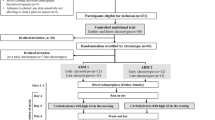Abstract
To investigate the contribution of glycosylated haemoglobin change (HbA1c) on body weight in patients with type 2 diabetes after start of insulin therapy. We analysed 122 individual weight-profiles in relation to the change in HbA1c per se in these patients up to 36 months after the start of insulin therapy. Data were analysed separately for the first 9 months after commencement of insulin therapy and for the period thereafter. Within the first 9 months of insulin therapy mean body weight increased by 0.52 kg per month. HbA1c decreased from 9.9 ± 1.8 to 7.9 ± 1.3%. Only 12% of the initial weight gain could be attributed to the change in HbA1c. Furthermore, the mean monthly increase in body weight gain was reduced by 0.006 kg for every 1 kg higher body weight at baseline. From 9 to 36 months after start of insulin therapy, body weight increased by 0.1 kg/month, which was independent of change in HbA1c. Improvement of glycaemic control per se contributes little to initial weight gain after start of insulin therapy in patients with T2DM. After 9 months of insulin treatment, weight gain is unrelated to change in glycosylated haemoglobin. Other factors have to be responsible for weight gain after start of insulin therapy.




Similar content being viewed by others
References
R.C. Turner, C.A. Cull, V. Frighi, R.R. Holman, Glycemic control with diet, sulfonylurea, metformin, or insulin in patients with type 2 diabetes mellitus: progressive requirement for multiple therapies (UKPDS 49). UK Prospective Diabetes Study (UKPDS) Group. JAMA 281, 2005–2012 (1999)
S. Makimattila, K. Nikkila, H. Yki-Jarvinen, Causes of weight gain during insulin therapy with and without metformin in patients with type II diabetes mellitus. Diabetologia 42, 406–412 (1999)
M.E. Hickey, T.R. Hall, Insulin therapy and weight change in Native-American NIDDM patients. Diabetes Care 16, 364–368 (1993)
J.Q. Purnell, J.E. Hokanson, S.M. Marcovina, M.W. Steffes, P.A. Cleary, J.D. Brunzell, Effect of excessive weight gain with intensive therapy of type 1 diabetes on lipid levels and blood pressure: results from the DCCT. Diabetes Control and Complications Trial. JAMA 280, 140–146 (1998)
D.A. McCarron, M.E. Reusser, Body weight and blood pressure regulation. Am. J. Clin. Nutr. 63, 423S–425S (1996)
S.E. Kahn, B. Zinman, S.M. Haffner et al., Obesity is a major determinant of the association of C-reactive protein levels and the metabolic syndrome in type 2 diabetes. Diabetes 55, 2357–2364 (2006)
H. Yki-Jarvinen, L. Ryysy, M. Kauppila et al., Effect of obesity on the response to insulin therapy in noninsulin-dependent diabetes mellitus. J. Clin. Endocrinol. Metab. 82, 4037–4043 (1997)
A. Salle, M. Ryan, G. Guilloteau, B. Bouhanick, G. Berrut, P. Ritz, ‘Glucose control-related’ and ‘non-glucose control-related’ effects of insulin on weight gain in newly insulin-treated type 2 diabetic patients. Br. J. Nutr. 94, 931–937 (2005)
S. Heller, Weight gain during insulin therapy in patients with type 2 diabetes mellitus. Diabetes Res. Clin. Pract. 65(Suppl 1), S23–S27 (2004)
A.N. Jacob, K. Salinas, B. ms-Huet, P. Raskin, Weight gain in type 2 diabetes mellitus. Diabetes Obes. Metab. 9, 386–393 (2007)
R.R. Holman, K.I. Thorne, A.J. Farmer et al., Addition of biphasic, prandial, or basal insulin to oral therapy in type 2 diabetes. N. Engl. J. Med. 357, 1716–1730 (2007)
G. Verbeke, G. Molenberghs, Linear mixed models in practice: a SAS-oriented approach (Springer-Verlag, New York, 1997)
R.R. Holman, A.J. Farmer, M.J. Davies et al., Three-year efficacy of complex insulin regimens in type 2 diabetes. N. Engl. J. Med. 361, 1736–1747 (2009)
D.S. Lasserson, P. Glasziou, R. Perera, R.R. Holman, A.J. Farmer, Optimal insulin regimens in type 2 diabetes mellitus: systematic review and meta-analyses. Diabetologia 52, 1990–2000 (2009)
R.A. DeFronzo, Insulin and renal sodium handling: clinical implications. Int. J. Obes. 5(suppl 1), 93–104 (1981)
R.R. Wolfe, Effects of insulin on muscle tissue. Curr. Opin. Clin. Nutr. Metab. Care 3, 67–71 (2000)
J. Rodin, J. Wack, E. Ferrannini, R.A. DeFronzo, Effect of insulin and glucose on feeding behavior. Metabolism 34, 826–831 (1985)
R. Gougeon, M. Lamarche, J.F. Yale, T. Venuta, The prediction of resting energy expenditure in type 2 diabetes mellitus is improved by factoring for glycemia. Int. J. Obes. Relat. Metab. Disord. 26, 1547–1552 (2002)
H.U. Janka, G. Plewe, M.C. Riddle, C. Kliebe-Frisch, M.A. Schweitzer, H. Yki-Jarvinen, Comparison of basal insulin added to oral agents versus twice-daily premixed insulin as initial insulin therapy for type 2 diabetes. Diabetes Care 28, 254–259 (2005)
The DCCT Research Group, Weight gain associated with intensive therapy in the diabetes control, complications trial. Diabetes Care 11, 567–573 (1988)
G. Biesenbach, A. Raml, N. Alsaraji, Weight gain and insulin requirement in type 2 diabetic patients during the first year after initiating insulin therapy dependent on baseline BMI. Diabetes Obes. Metab. 8, 669–673 (2006)
UK Prospective Diabetes Study (UKPDS) Group, Intensive blood-glucose control with sulphonylureas or insulin compared with conventional treatment, risk of complications in patients with type 2 diabetes (UKPDS 33). Lancet 352, 837–853 (1998)
Conflict of interest
None.
Author information
Authors and Affiliations
Corresponding author
Rights and permissions
About this article
Cite this article
Jansen, H.J., Hendriks, J.C., de Galan, B.E. et al. Contribution of change in glycosylated haemoglobin to insulin-associated weight gain: results of a longitudinal study in type 2 diabetic patients. Endocr 39, 190–197 (2011). https://doi.org/10.1007/s12020-010-9423-4
Received:
Accepted:
Published:
Issue Date:
DOI: https://doi.org/10.1007/s12020-010-9423-4




